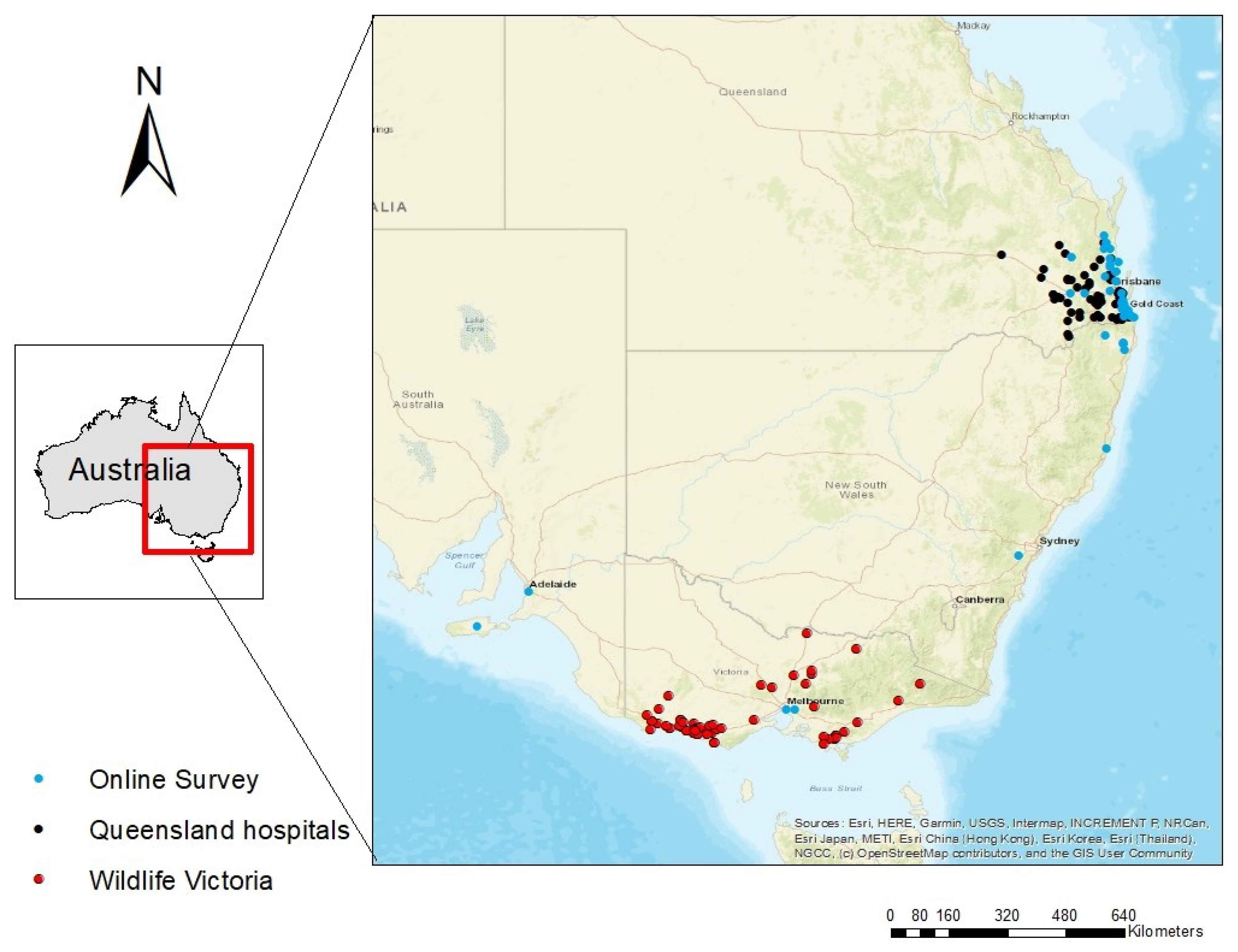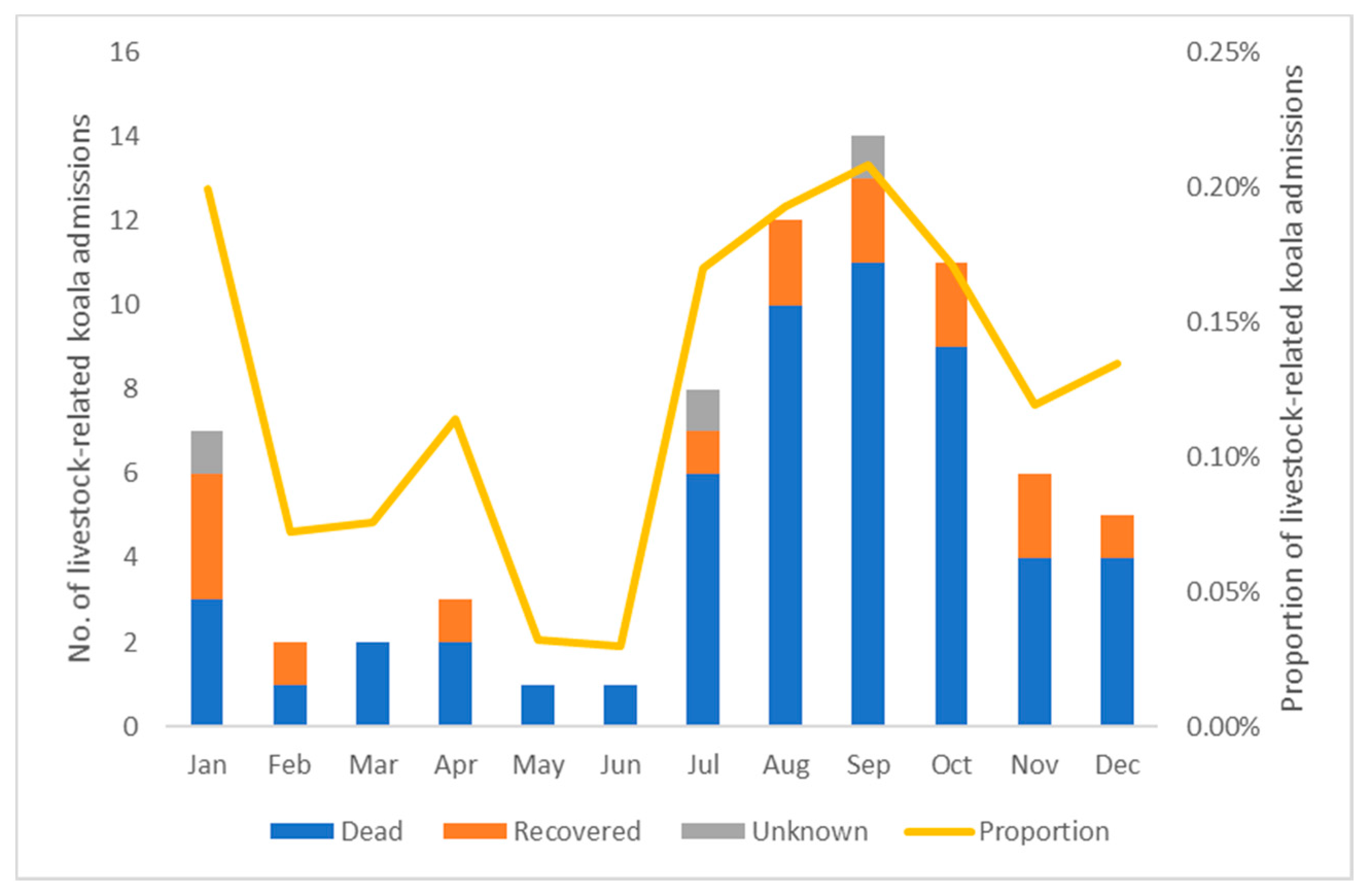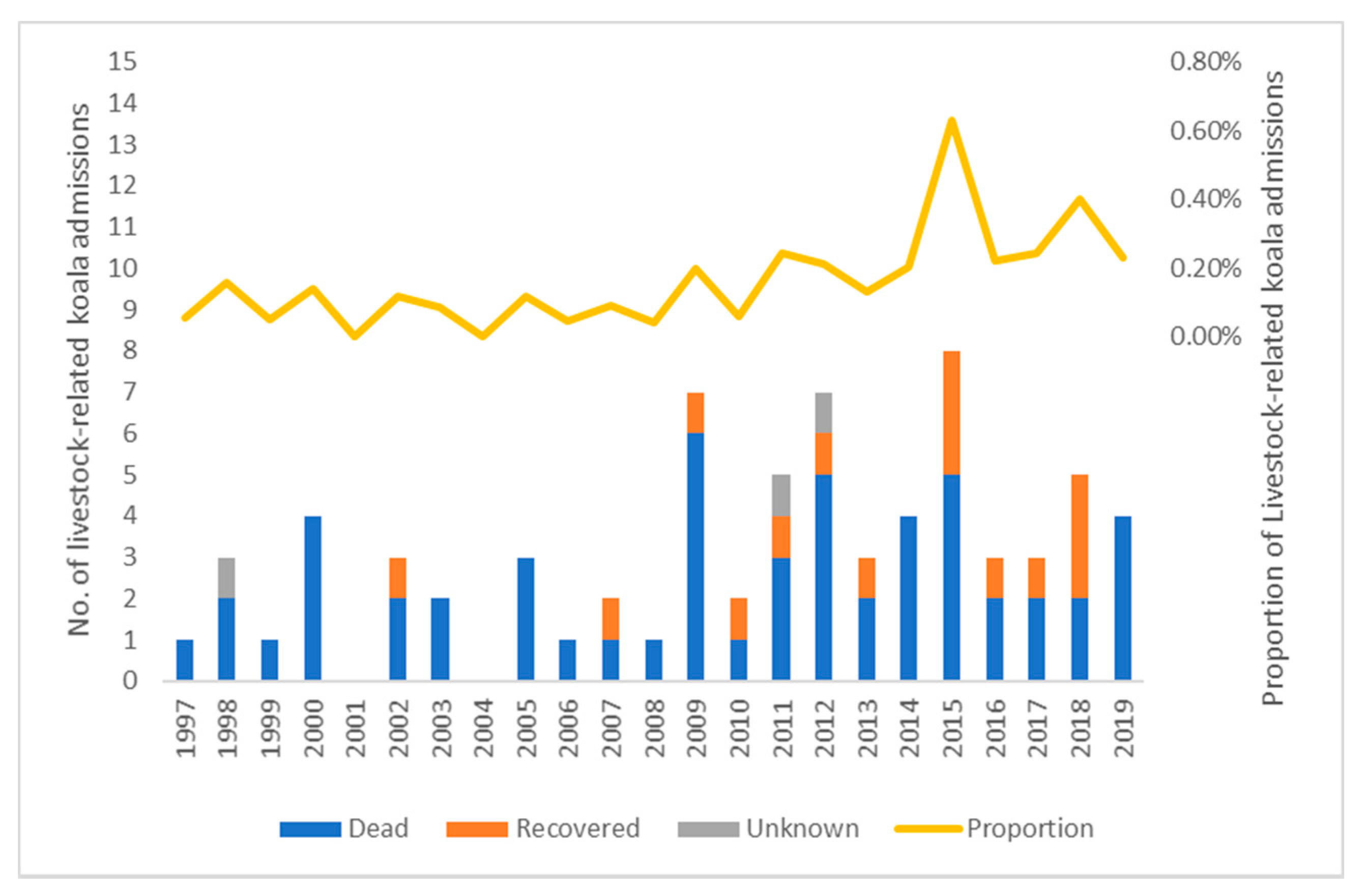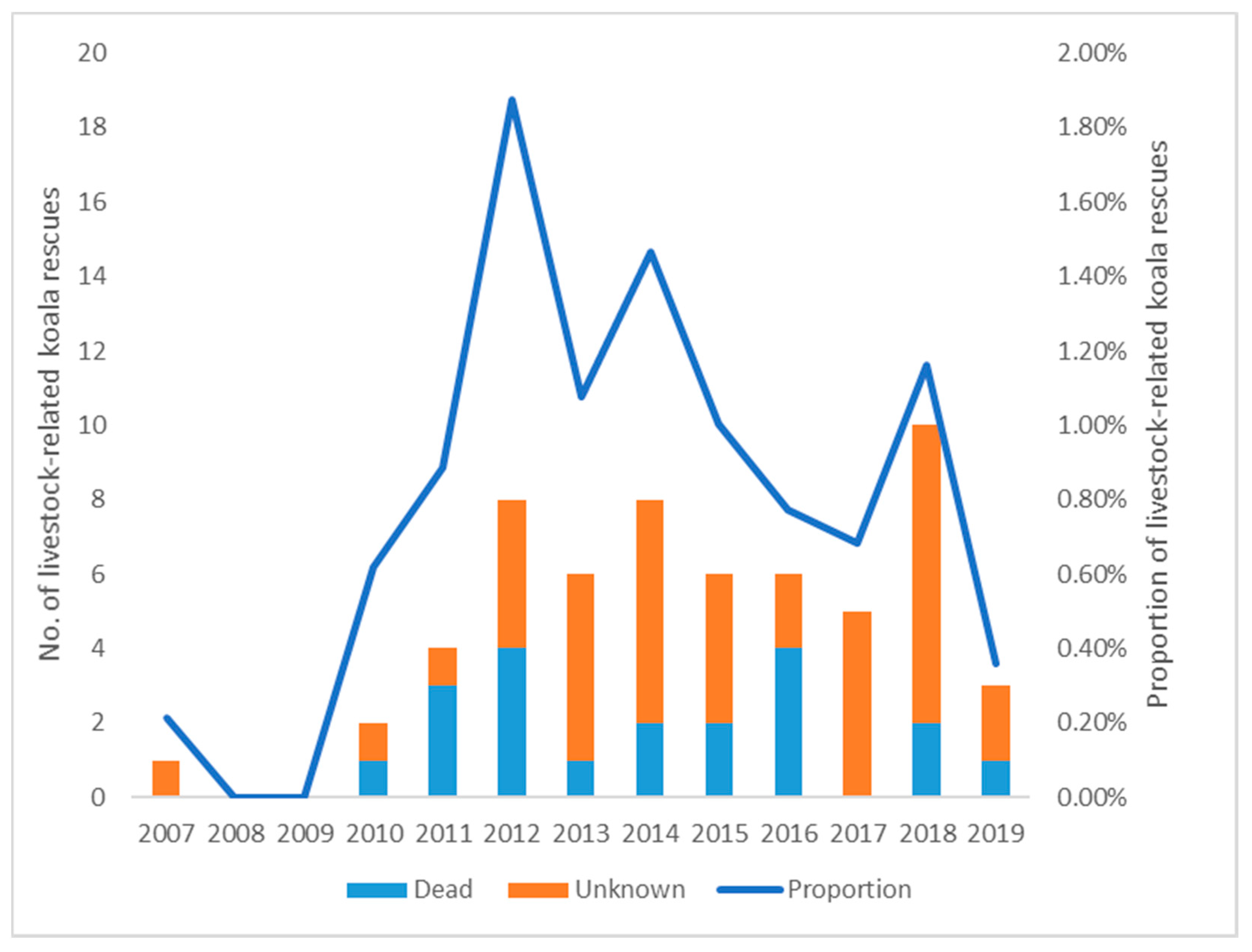Do Livestock Injure and Kill Koalas? Insights from Wildlife Hospital and Rescue Group Admissions and an Online Survey of Livestock–Koala Conflicts
Abstract
:Simple Summary
Abstract
1. Introduction
2. Materials and Methods
2.1. Online Survey
2.2. Admission Records
3. Results
3.1. Online Survey
3.2. Admission Records
4. Discussion
- The Location of Incidents
- The Experience of Veterinarians
- Potential Reluctance of Graziers to Report Incidents
5. Conclusions
Author Contributions
Funding
Institutional Review Board Statement
Informed Consent Statement
Data Availability Statement
Acknowledgments
Conflicts of Interest
Appendix A. Survey of Livestock-Inflicted Injuries/Deaths to Koalas
- As part of your job, are you dealing with injured/dead koalas in ways of reporting, handling, caring, rehabilitation or necropsy?
- Yes
- No
- As an individual (not your hospital/clinic/organisation), how often do YOU receive/process injured/dead koalas every year?
- More than weekly
- Weekly
- Fortnightly
- Monthly
- Less than monthly
- If you have specific details of the number please specify:
- Have you ever heard of (but NOT been directly involved with or seen) koalas injured or killed by livestock within your local area?
- Yes
- No
- If yes, how often do you hear of this happening?
- 12+ times yearly
- 7–12 times yearly
- 1–6 times yearly
- only a few times over the past years
- Where do you hear it from?
- Hospitals or clinics
- Rescue carers
- Farmers
- Social Media
- News (TV, internet, etc.)
- Others (please specify)
- Have you ever handled (for treatment, rehabilitation or necropsy), or seen, koalas that have DEFINITELY been injured or killed by livestock?
- Yes
- No
- Of these CONFIRMED cases, how do you know that the koalas were DEFINITELY injured or killed by livestock?
- You have witnessed the incidents when happening
- Testimony from people who found the koala
- Robust clinical evidence
- Others (please specify)
- What is the robust clinical evidence that confirms the injures/deaths of koalas are caused by livestock? (e.g., livestock hoof prints on koala body, livestock bite marks, etc.)
- How often do you handle/see such CONFIRMED incidents?
- 12+ times yearly
- 7–12 times yearly
- 1–6 times yearly
- only a few times over the past years.
- Of these confirmed cases, how many were caused by CATTLE rather than by other livestock?
- Almost all
- More than half
- About half
- Less than half
- Nearly none
- Unable to estimate due to limited evidence
- Have you ever handled or seen koalas that MAY have been injured or killed by livestock?
- Yes
- No
- Of these POSSIBLE cases, how do you know these injures/deaths MIGHT have been caused by livestock?
- Case report
- Location of the incident—from livestock paddock
- Clinical evidence, please specify
- Others (please specify)
- What is the clinical evidence that indicates the injures/deaths of koalas are POSSIBLY caused by livestock?
- How often do you handle/see such POSSIBLE incidents?
- 12+ times yearly
- 7–12 times yearly
- 1–6 times yearly
- only a few times over the past years.
- Of these possible cases, how many might have been caused by CATTLE rather than by other livestock?
- Almost all
- More than half
- About half
- Less than half
- Nearly none
- Unable to estimate due to limited evidence
- Of those koalas possibly or definitely injured by livestock, how many have survived to be released?
- Almost all
- More than half
- About half
- Less than half
- Nearly none
- Don’t know
- Have you ever seen any other wildlife possibly injured or killed by livestock, and if so please tick the boxes below:
- Never
- Kangaroos/Wallabies
- Rabbits/Hares
- Snakes
- Dogs/Dingoes
- Cats
- Foxes
- Possums
- Echidnas
- Small marsupial species e.g., bandicoots, phascogales, etc.
- Others, please specify
- If you have seen any cases of koalas injured/killed by livestock please give a brief case description:
- Any other comments in relation to livestock-inflicted injuries/deaths to koalas, please specify:
- If you are happy to be contacted for further information, or interested in the final outcome of this survey, please leave your email address below, and a brief report will be sent to you when available.
- Email address
Appendix B. Livestock–Koala Incident Online Survey Invitation Recipient List
References
- McAlpine, C.; Lunney, D.; Melzer, A.; Menkhorst, P.; Phillips, S.; Phalen, D.; Ellis, W.; Foley, W.; Baxter, G.; de Villiers, D.; et al. Conserving koalas: A review of the contrasting regional trends, outlooks and policy challenges. Biol. Conserv. 2015, 192, 226–236. [Google Scholar] [CrossRef]
- Seabrook, L.; McAlpine, C.; Baxter, G.; Rhodes, J.; Bradley, A.; Lunney, D. Drought-driven change in wildlife distribution and numbers: A case study of koalas in south west Queensland. Wildl. Res. 2011, 38, 509–524. [Google Scholar] [CrossRef]
- Rhodes, J.R.; Beyer, H.L.; Preece, H.J.; McAlpine, C.A. South East Queensland Koala Population Modelling Study; UniQuest: Brisbane, Australia, 2015. [Google Scholar]
- Moyal, A. Koala: A Historical Biography; CSIRO Publishing: Melbourne, Australia, 2009. [Google Scholar]
- Rhodes, J.R.; Wiegand, T.; McAlpine, C.A.; Callaghan, J.; Lunney, D.; Bowen, M.; Possingham, H.P. Modeling species’ distributions to improve conservation in semiurban landscapes: Koala case study. Conserv. Biol. 2006, 20, 449–459. [Google Scholar] [CrossRef] [PubMed]
- McAlpine, C.A.; Rhodes, J.R.; Callaghan, J.G.; Bowen, M.E.; Lunney, D.; Mitchell, D.L.; Pullar, D.V.; Possingham, H.P. The importance of forest area and configuration relative to local habitat factors for conserving forest mammals: A case study of koalas in Queensland, Australia. Biol. Conserv. 2006, 132, 153–165. [Google Scholar] [CrossRef]
- Grogan, L.F.; Peel, A.J.; Kerlin, D.; Ellis, W.; Jones, D.; Hero, J.-M.; McCallum, H. Is disease a major causal factor in declines? An Evidence Framework and case study on koala chlamydiosis. Biol. Conserv. 2018, 221, 334–344. [Google Scholar] [CrossRef] [Green Version]
- Hanger, J.; de Villiers, D.; Forbes, N.; Nottidge, B.; Beyer, H.; Loader, J.; Timms, P. Final Technical Report: Moreton Bay Rail Koala Management Program; Department of Transport and Main Roads: Brisbane, Australia, 2017.
- Gonzalez-Astudillo, V.; Allavena, R.; McKinnon, A.; Larkin, R.; Henning, J. Decline causes of Koalas in South East Queensland, Australia: A 17-year retrospective study of mortality and morbidity. Sci. Rep. 2017, 7, 42587. [Google Scholar] [CrossRef] [PubMed] [Green Version]
- Lunney, D.; Stalenberg, E.; Santika, T.; Rhodes, J.R. Extinction in Eden: Identifying the role of climate change in the decline of the koala in south-eastern NSW. Wildl. Res. 2014, 41, 22–34. [Google Scholar] [CrossRef] [Green Version]
- Phillips, S.; Wallis, K.; Lane, A. Quantifying the impacts of bushfire on populations of wild koalas (Phascolarctos cinereus): Insights from the 2019/20 fire season. Ecol. Manag. Restor. 2021, 22, 80–88. [Google Scholar] [CrossRef]
- ContentMint. Cows Stalking a Cute Koala on a Farm. Available online: https://www.youtube.com/watch?v=Hg28MUxnURQ (accessed on 12 August 2021).
- Scramblerbill. Koala Meets Cows in Australia. Available online: https://www.youtube.com/watch?v=dXL489RBNOc (accessed on 12 August 2021).
- Ryan, K. Mad Cows Attack Helpless Wildlife. Available online: https://www.couriermail.com.au/ipad/mad-cows-attack-helpless-wildlife/news-story/987916750779f4c31d3746d9f0d60a76 (accessed on 12 August 2021).
- Rebgetz, L. Koalas Being Trampled by Livestock Amid Habitat Loss, Wildlife Experts Say. Available online: http://www.abc.net.au/news/2017-06-17/livestock-attacks-koalas-more-common-wildlife-experts-say/8625762 (accessed on 12 August 2021).
- Mitchell-Whittington, A. Koalas Are Being Attacked by Cattle, Horses as Trees Are Felled: Wildlife Carer. Available online: https://www.brisbanetimes.com.au/national/queensland/koalas-are-being-attacked-by-cattle-horses-as-trees-are-felled-wildlife-carer-20170619-gwtucn.html (accessed on 12 August 2021).
- Hill, A.; Keogh, S.; Anderson, B. Case study: Cattle-associated traumatic injuries in koalas (Phascolarctos cinereus), 2010–2016. Wildl. Rehab. Med. 2019, 39, 11–15. [Google Scholar]
- Henning, J.; Hannon, C.; McKinnon, A.; Larkin, R.; Allavena, R. The causes and prognoses of different types of fractures in wild koalas submitted to wildlife hospitals. Prev. Vet. Med. 2015, 122, 371–378. [Google Scholar] [CrossRef] [PubMed]
- Preece, H.J. Monitoring and Modelling Threats to Koala Populations in Rapidly Urbanising Landscapes: Koala Coast, South East Queensland, Australia. Ph.D. Thesis, The University of Queensland, St Lucia, Australia, 2007. [Google Scholar]
- Phillips, C. Cattle Behaviour and Welfare, 2nd ed.; Wiley: Hoboken, NJ, USA, 2008. [Google Scholar]
- Department of Environment and Science. KoalaBase. Available online: https://www.data.qld.gov.au/dataset/koala-hospital-data/resource/7c6f7da8-ef7a-48e4-bf4e-c449a885e46d (accessed on 12 August 2021).
- Phillips, C.J.C. Cattle Behaviour; Farming Press: Ipswich, UK, 1993. [Google Scholar]
- Griffith, J.E.; Higgins, D.P. Diagnosis, treatment and outcomes for koala chlamydiosis at a rehabilitation facility (1995–2005). Aust. Vet. J. 2012, 90, 457–463. [Google Scholar] [CrossRef] [PubMed]
- Griffith, J.E.; Dhand, N.K.; Krockenberger, M.B.; Higgins, D.P. A retrospective study of admission trends of koalas to a rehabilitation facility over 30 years. J. Wildl. Dis. 2013, 49, 18–28. [Google Scholar] [CrossRef] [PubMed] [Green Version]
- Jim, T.; Harriet, J.P.; Guy, C.P.; Deidré, L.d.V.; Ros, S.L. Koala mortality on roads in south-east Queensland: The koala speed-zone trial. Wildl. Res. 2003, 30, 419–426. [Google Scholar] [CrossRef]
- Melzer, A.; Carrick, F.; Menkhorst, P.; Lunney, D.; John, B.S. Overview, Critical Assessment, and Conservation Implications of Koala Distribution and Abundance. Conserv. Biol. 2000, 14, 619–628. [Google Scholar] [CrossRef]
- Australian Bureau of Statistics. Historical Selected Agriculture Commodities, by State (1861 to Present), 2010–2011. Available online: https://www.abs.gov.au/ausstats/abs@.nsf/Lookup/7124.0Chapter102010-11 (accessed on 12 August 2021).
- Australia Zoo. Australia Zoo Wildlife Hospital. Available online: https://wildlifewarriors.org.au/conservation-projects/australia-zoo-wildlife-hospital (accessed on 12 August 2021).
- Burton, E.; Tribe, A. The rescue and rehabilitation of koalas (Phascolarctos cinereus) in Southeast Queensland. Animals 2016, 6, 56. [Google Scholar] [CrossRef] [PubMed] [Green Version]
- Turner, S.P.; Lawrence, A.B. Relationship between maternal defensive aggression, fear of handling and other maternal care traits in beef cows. Livest. Sci. 2007, 106, 182–188. [Google Scholar] [CrossRef]
- Fraser-Williams, A.P.; McIntyre, K.M.; Westgarth, C. Are cattle dangerous to walkers? A scoping review. Inj. Prev. 2016, 22, 437–441. [Google Scholar] [CrossRef] [PubMed]
- Pilkington, M.; Wilson, G. Australian Horses as a Primary Industry: Numbers, Organisation and Research Needs; Australian Government Publishing Service: Canberra, Australia, 1993. [Google Scholar]
- Australian Bureau of Statistics. Agricultural Commodities, Australia, 2017–2018; Australian Bureau of Statistics: Canberra, Australia, 2019.
- Hausberger, M.; Søndergaard, E.; Martin-Rosset, W. Horse Behaviour and Welfare; Wageningen Academic Publishers: Wageningen, The Netherlands, 2007. [Google Scholar]
- Rhind, S.G.; Ellis, M.V.; Smith, M.; Lunney, D. Do Koalas ‘Phascolarctos cinereus’ use trees planted on farms?: A case study from north-west New South Wales, Australia. Pac. Conserv. Biol. 2014, 20, 302–312. [Google Scholar]
- Dargan, J.R.; Moriyama, M.; Mella, V.S.A.; Lunney, D.; Crowther, M.S. The challenge for koala conservation on private land: Koala habitat use varies with season on a fragmented rural landscape. Anim. Conserv. 2019, 22, 543–555. [Google Scholar] [CrossRef]




| Total Number of Respondents | Confirmed | Possible | Heard | |
|---|---|---|---|---|
| 26 | 27 | 38 | ||
| Evidence | Observed in field | 8 | n/a | n/a |
| Witness report | 18 | 3 | n/a | |
| Location—found in paddocks | n/a | 22 | n/a | |
| Clinical evidence | 7 | 7 | n/a | |
| Frequency | Only a few cases over the past years | 19 | 16 | 21 |
| 1–6 cases every year | 6 | 9 | 12 | |
| 7–12 cases every year | 0 | 0 | 3 | |
| 12+ cases every year | 1 | 2 | 2 | |
| Outcome for koala | Almost all survived | 0 | n/a | |
| More than half survived | 0 | n/a | ||
| About half survived | 1 | n/a | ||
| Less than half survived | 6 | n/a | ||
| Nearly none survived | 14 | n/a | ||
| Unknown outcome | 10 | n/a | ||
| Cattle involved | Almost all cases | 20 | 14 | n/a |
| More than half of the cases | 0 | 1 | n/a | |
| About half of the cases | 1 | 2 | n/a | |
| Less than half of the cases | 2 | 1 | n/a | |
| Nearly none of the cases | 1 | 1 | n/a | |
| Unknown | 2 | 8 | n/a | |
| QLD Koala Hospital | Cattle | Cattle Total | Horses | Horse Total | Sheep | Sheep Total | Grand Total | |||
|---|---|---|---|---|---|---|---|---|---|---|
| Dead | Recovered | Unknown | Dead | Recovered | Dead | |||||
| Confirmed | 38 | 10 | 3 | 51 | 14 | 5 | 19 | 70 | ||
| Adult | 29 | 6 | 3 | 38 | 13 | 3 | 16 | 54 | ||
| Female | 15 | 1 | 1 | 17 | 6 | 2 | 8 | 25 | ||
| Male | 6 | 1 | 1 | 8 | 3 | 3 | 11 | |||
| Unknown | 8 | 4 | 1 | 13 | 4 | 1 | 5 | 18 | ||
| Sub-Adult | 5 | 2 | 7 | 2 | 2 | 9 | ||||
| Female | 2 | 2 | 2 | 2 | 4 | |||||
| Male | 5 | 5 | 5 | |||||||
| Young | 4 | 2 | 6 | 1 | 1 | 7 | ||||
| Female | 2 | 2 | 1 | 1 | 3 | |||||
| Male | 2 | 2 | 4 | 4 | ||||||
| Possible | 1 | 1 | 1 | 1 | 2 | |||||
| Adult | 1 | 1 | 1 | 1 | 2 | |||||
| Female | 1 | 1 | 1 | |||||||
| Male | 1 | 1 | 1 | |||||||
| Grand Total | 38 | 10 | 3 | 51 | 15 | 5 | 20 | 1 | 1 | 72 |
| Wildlife Victoria | Dead | Unknown | Grand Total |
|---|---|---|---|
| Confirmed | 11 | 13 | 24 |
| Possible | 9 | 26 | 35 |
| Grand Total | 20 | 39 | 59 |
Publisher’s Note: MDPI stays neutral with regard to jurisdictional claims in published maps and institutional affiliations. |
© 2021 by the authors. Licensee MDPI, Basel, Switzerland. This article is an open access article distributed under the terms and conditions of the Creative Commons Attribution (CC BY) license (https://creativecommons.org/licenses/by/4.0/).
Share and Cite
Jiang, A.; Tribe, A.; Phillips, C.J.C.; Murray, P.J. Do Livestock Injure and Kill Koalas? Insights from Wildlife Hospital and Rescue Group Admissions and an Online Survey of Livestock–Koala Conflicts. Animals 2021, 11, 2684. https://doi.org/10.3390/ani11092684
Jiang A, Tribe A, Phillips CJC, Murray PJ. Do Livestock Injure and Kill Koalas? Insights from Wildlife Hospital and Rescue Group Admissions and an Online Survey of Livestock–Koala Conflicts. Animals. 2021; 11(9):2684. https://doi.org/10.3390/ani11092684
Chicago/Turabian StyleJiang, Alex, Andrew Tribe, Clive J. C. Phillips, and Peter J. Murray. 2021. "Do Livestock Injure and Kill Koalas? Insights from Wildlife Hospital and Rescue Group Admissions and an Online Survey of Livestock–Koala Conflicts" Animals 11, no. 9: 2684. https://doi.org/10.3390/ani11092684
APA StyleJiang, A., Tribe, A., Phillips, C. J. C., & Murray, P. J. (2021). Do Livestock Injure and Kill Koalas? Insights from Wildlife Hospital and Rescue Group Admissions and an Online Survey of Livestock–Koala Conflicts. Animals, 11(9), 2684. https://doi.org/10.3390/ani11092684







